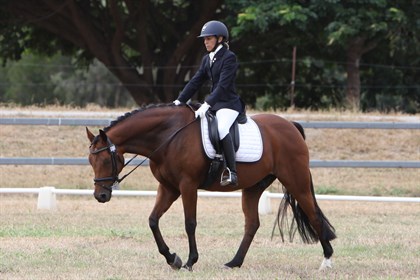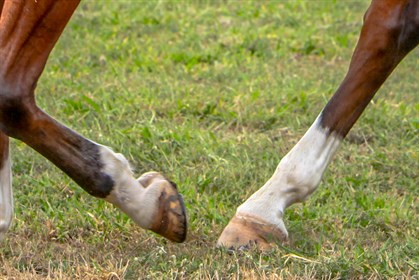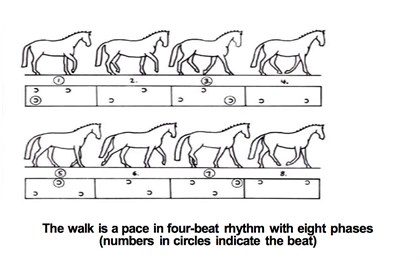|

|
This article has appeared previously with Equestrian Life. To see what's in our latest digital issue, click here.

A good demonstration of the long rein walk.
© Roger Fitzhardinge
By Roger Fitzhardinge
The walk is a pace that is said to demonstrate the correctness of dressage training. It is of vital importance and needs a very attentive rider to pay special attention to its every need.
MOVEMENTS IN THE walk at almost all levels to Grand Prix are worth double marks, so can have considerable influence on the overall percentage score. In young horse classes, the walk carries the same mark as trot and canter, and constitutes 20 per cent of the total score. The walk is a clear, even, marching movement with four clearly defined steps (one/two/three/four, not one-two/three-four), with the tempo metonymically four even-spaced beats. The footfalls are left hind to left fore, then right hind to right fore. A horse with a good walk will be seen to move through his whole body, just like a slinky model moving along the catwalk. It’s not just about moving the legs. The most obvious criteria to a good walk is a large overtrack, but this must be combined with the slinky model attitude in all the walk movements; the head and neck must be able to move forward and back with each step. When watching a good walk, the moment the hind hoof comes to the fore hoof, the cannon bones form a momentary “V”, and this “V” must present in every stride. The visual that separates the walk from collected to long rein is the topline frame/outline and the degree of overtrack. The four walks – collected, medium, extended and long rein – must all show the purity of the pace.

The V as the hind hoof comes to the front foot. There is an imaginary line drawn down the cannon bones to form the V.
© Roger Fitzhardinge
THE FOUR WALKS
1. Collected
Round and plump frame with the poll the highest point and nose approaching the vertical. The horse remains uphill and the steps active (not slow), with the hind foot not creating an overtrack but stepping into the footfall of the front hoof. This shortened step is all-important and must be associated with collection, a clear four-beat and clear “V”. The ultimate sensation of a good collected walk is a feeling that at any moment a piaffe transition could occur.
2. Medium
Is not as collected and the frame a little lower and longer. There is a moderate overtrack, the poll still the highest point, and good purpose and forward desire with the forward and back movement of the neck. The steps remain active and the “V” and rhythm of the utmost importance.
3. Extended
Is longer and lower again in the frame, still on the bit. The walk steps are of maximum overtrack and full of purpose. There should be at least a good hoofprint overtrack and very good walks, even up to three or four hoofprints. The walk should show a degree of relaxation yet have positive energy and show a desire to move within or out of any walk.
4. Long and loose rein
Is where the neck is allowed total freedom. The difference is in the contact, loose (loops) where the contact to the mouth can be loose and not at all connected. Long rein is where there is still some contact to the rider’s hands with the horse drawing forward into the long rein. The steps are relaxed and should show the greatest degree of overtrack and purpose.
The quality of the walk training is proven by the clarity of the four equal beats, the uninterrupted “V”, and maintaining relaxation, all while displaying confidence and posture. The good walk should also always be definite and have a really good marching feeling, which should translate into high marks in the arena.

The walk is a pace in four-beat rhythm with eight phases (numbers in circles indicate the beat).
AVOID SPOILING A GOOD WALK
Tension is a killer with the walk, so the less fiddling you do early on the better. Do not try to collect the walk early in training; initially use the trot pace to establish “on the bit”. Once a good feeling and contact is understood in halt and in trot, then it will filter down and be understood by the horse in the walk, rather than training and creating tension in the contact and neck in the walk. Make sure the walk is a relaxed pace so the horse learns it is a calm place to be. If lunging, never walk in fixed side reins, as this does not allow the neck to move forward and back and will encourage a lateral walk. The main training problem that produces an incorrect walk is bad contact. Too short and unyielding contact with no allowance for the neck to move creates a tense neck/back and body and encourages a horse to amble and be lateral, as the front hoof leaves the ground too early or you may think the hindleg is too slow. When this happens, the four-beat rhythm is interrupted and becomes one-two/three-four and not one/two/three/four! This rhythm can be easily heard if the horse is on a firm surface. Without the sound, the eye will notice the lack of hoof to hoof, or the “V”. The horse moves laterally, that is, near-hind and near-fore together and off-hind and off-fore together. The walk looks as a camel would walk or how a pacer moves.
HOW TO ENCOURAGE A BETTER WALK
Initially, forward, calm, deliberate steps on a long to loose rein is the way to go. Make sure from the start that the rider’s leg remains quiet and hanging downwards. It’s so easy to kick, kick, kick in the walk, and when you stop tapping, so does the walk; this is counter-productive as you are inadvertently teaching the horse to be dull to your aids.
When the time to work on the bit is right, always make sure you get a release to the rein contact and the horse doesn’t just brace against the bit. This release in the poll and the jaw/neck allows the horse to let go and use the whole back and body to move. If you get a few irregular steps as the horse resists and leans on the bit, remain committed and positive until you feel the release. With this thoroughness, you will feel every relaxation throughout the horse and an immediately swinging walk. Don’t hold the more collected steps for too long. It’s best to do this exercise on a circle as the bend, flexion and turning encourages a quicker hindleg and so a better walk. Turns on the forehand at the walk are another useful exercise, encouraging a quicker hindleg and a rounder outline and yielding.
IN THE COMPETITION ARENA
The only other movements in walk to get marks will be the turn on the haunches and pirouette (same family, so to speak). The walk pirouette is where the walk steps can easily become lateral, which quickly results in low marks. As I outlined earlier, the reasons for this happening are: (1) Lazy, slow walk steps; (2) Blocked contact, creating a hollow outline; (3) Dull reaction to the leg.
The pirouette should be trained larger than completion size and the horse must never be lazy and step against the bridle or be dull to the leg. The major problem is always in the preparation when the walk is collected, and becomes dull and slow… disaster! The rein aids then are too strong and the walk wants to stall. Slow hindleg = lateral steps! Remember, the walk purity and activity must be the same when walking into the pirouette as when you walk out of the pirouette. Always remember, never train in the walk for too long on the bit and collected.
FIXING A LATERAL WALK
Prevention is better than cure. Once a lateral walk is developed, it can be hard fault to correct due to the horse naturally finding it lazier and easier than a correct walk. Do not collect the walk in training if any lateral steps appear. Analyse why the walk is becoming lateral, that is, is it tension, lethargy, contact resistance, neck too high, inherent? It’s always important to have experienced eyes on the ground when correcting a lateral walk as sometimes it’s not easy to feel and fix. Once you have worked out why your horse is taking lateral steps, diagnose why the steps are lacking purity then find good eyes on the ground and set about setting a treatment regime.
The important thing is to make sure the hind hoof gets to the front hoof before it leaves the ground. You have two choices to help this: Hurry the hind leg so it gets to the front hoof quicker; or slow the front foot down until the hind hoof has a chance to get there. The best advice is to have a forward-moving walk that doesn’t stall when you pick up the contact. The horse must learn to yield to the contact and go “through” from the front to the back and the back to the front. If the steps turn uneven, ride shoulder-in on a turning line or circle to hurry the hindleg and control the forehand. A good exercise is to try making a square and at each corner, collect a little and make a quarter of a turn on the forehand then walk forwards straight. This encourages a quicker hindleg and a slower foreleg as you shorten and turn and will help keep the leg regular four-beat.
WALK CHECKLIST
Does your walk show...
• Confidence?
• Even steps in all walks, especially collection, where positive activity is contained?
• Quiet and accepting contact?
• Energy and lightness to follow the rein from collected to extended?
• Active acceptance of the leg?
• A willingness and alert mind to proceed in whatever transition is asked with confidence (halt, trot, canter, pirouette, piaffe, passage)?
|

|

